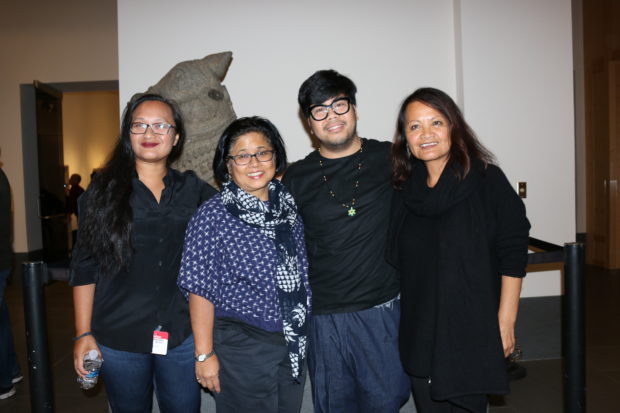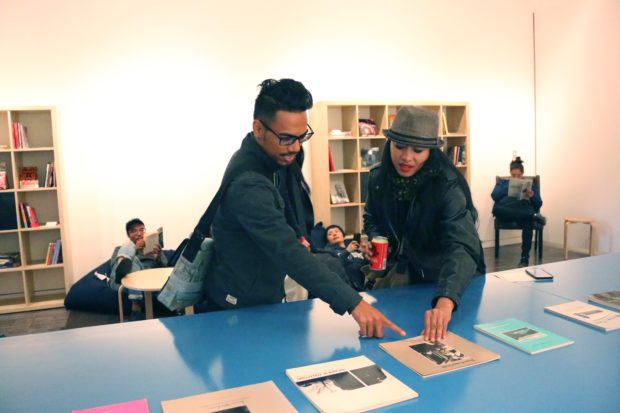Pilipinx American Library pops up at SF Asian Art Museum

Poets, artists (from left) Barbara Jane Reyes, Catalina Cariaga, PJ Gubatina Policarpio, and Shirley Ancheta at PAL pop-up library at San Francisco Asian Art Museum. ERINA ALEJO
SAN FRANCISCO – A one of a kind, mobile, non-circulating, pop-up library known as the Pilipinx American Library (PAL) is at the Asian Art Museum for the entire month of August,
turning the Resource Room of the museum into a reading room and gathering space to highlight the writings of Filipino American poets.
Featured are the works of activist and oral historian Al Robles (1930–2009), feminist experimental poet Barbara Jane Reyes, and Kearny Street Workshop (KSW) poets. Special event programs are also scheduled on Thursdays and Saturdays throughout the month of August.
In putting the project together, PJ Gubatina Policarpio, a socially engaged educator, curator, programmer, writer, community organizer, and co-founder of PAL, was inspired by a line from an Al Robles poem that goes, I dreamt of a place to gather.
“So, it’s really that place to gather, to be surrounded by books. My hope is not just to have the books, but to also have the space where people gather.”
PAL/The Pilipinx American Library at the Asian Art Museumis a collaborative project of Policarpio and the museum’s senior educator of contemporary art, Marc Mayer. Mayer invited Policarpio to engage with the space and transform the Resource Room into a library.
“I’ve worked closely with Marc to develop the space and the series of programs that are linked and help engage with and illuminate the books and the writers that are featured.”
Collaborations
They also collaborated with other organizations and community partners: TAYO Literary Magazine; Manilatown Heritage Center; and KSW.
Policarpio had thought deeply and reflected on what will make the Asian Art Museum program different from the PAL programs in the past.
“We’ve done a program on [Carlos] Bulosan; we’ve done a program on contemporary writers in New York; I think what makes PAL special is that, because we are mobile, we adapt to what is the history and the culture of the space we’re in.”
In coming up with the program at the Asian Art Museum, Policarpio deemed it important to begin with Al Robles.
“We could not exist in San Francisco without having to talk about Al Robles; what he’s done in writing for the community and being our historian, being able to transcribe the stories of the manongs of Manilatown in Kearny Street.”

Rani Marcos and Golda Sargento browse the collection at the PAP pop-up library. ERINA ALEJO
In thinking about Robles, Policarpio wanted to expand the focus to Robles’ “community of friends, fellow writers, and fellow poets.” This brought him to KSW, the epicenter of Asian American/Filipino American writing, art, and activism since its inception in 1972.
“That community really fostered that history and really wrote about it.”
Then, after looking back, he shifted his sight to the present. “I also wanted it to be something that could bring a fresh perspective, a nuanced contemporary voice.” And Policarpio decided to add as a third focus, the poet, Barbara Jane Reyes, whose recent book, Invocation to Daughters,is published by City Lights Books.
“I thought that those are the three different connective threads I wanted this pop-up to come out of. That helped us think about what the rest of the programming would look like.”
Bicoastal pop-up
A bicoastal pop-up library, PAL was founded in the fall of 2016 in Queens, New York, by Policarpio and co-founder, artist, Emmy Catedral.
“Living in Queens, where there is actually a big Filipino American community, I was just thinking about ways that Filipinos and other people can find a connection, engage with, or encounter Pilipinx/Filipino books and literature.”
Policarpio and Catedral, both bibliophiles and collectors, heard the call to bring more awareness about Filipino and Filipino American literature and to make it accessible to the public.
“People kept saying, ‘I’ve never read a Filipino or Filipino American writer before’ or ‘I’ve never read any book with Filipino or Filipino American characters, stories, histories, or poetry’. This was both for Fil-Ams and non-Filipinos alike.”
Incidentally, PAL was founded during the fall of the election year of 2016, “When the rhetoric was really violent against immigrants or those deemed as not from here; so it’s coupled with that idea—that we have been here, our history—Filipino history—is directly linked to American history, American stories. So, our stories, in fact, are American stories as well.”
This spurred Policarpio and Catedral to galvanize. They decided to consolidate their book collection and established what became the Pilipinx American Library.
“It is important to have our voices out there, it is important to have our stories out there. Especially if we are being vilified.”
Non-circulating but browsable
As a non-circulating library, the books are not on loan, but people can browse the collection, sample the books, take home a reading list, then find it or request it from their local library, or buy their own copy.
“It’s our books, so people can’t take them home, but we put together reading lists they can take. It has the titles and the author’s names. That’s one way we can say that if you really like this book, you may also enjoy this other book, or this is a good way for you to start.”
Part of PAL’s mission is creating spaces to give people access to start reading and get to know writers and poets from the Filipino diaspora.
“It’s a very personal collection that is made public. What we like is making these moments where people don’t expect to see the books but encounter them; an unexpected encounter with Filipino American books that are still not being published regularly, still very marginalized voices.”
Beyond literature, Policarpio and Catedral also collect artist books, zines, and other printed matter that relate to the Filipino American identity, community, and the diaspora that they also share in their pop-ups.
“It’s a labor of love. It starts from our collection. It stems from our love of literature, our love of books, also our love for the Filipino and the Filipino American experience and the community. We are here in the United States. We’ve been here. We’ve been writing our stories here.”
PAL is always looking at expanding their collection. Other than continuing to build their personal collection, they are always taking in donations.
“The only restriction is that we will privilege and we are dedicated exclusively to publications and printed matter that are authored by Filipino/Pilipinx voices or feature really strong Filipino/Pilipinx narratives. If you are a writer who identifies as Filipino/Filipino American, we’d love to have your book in the collection.”
The opening night took place on August 2 with a well-attended program at the museum. Barbara Jane Reyes did a reading along with Catalina Cariaga, author of Cultural Evidence (1999), and KSW pioneer poet, Shirley Ancheta.
“I asked Barbara Jane who she would like to read with, and these [poets] are her mentors, her elders in the literary poetic tradition,” says Policarpio. “She’s like, ‘No doubt these are the women I would want to read with.’.That was a special moment to hear them read their works.”
Special programs
A number of special programs are in store such as the PAL Artists Retreat, a daylong gathering of writers, artists, curators, and cultural workers happening on August 11.
“If you are a Filipino or Filipino American artist, this is a very important space for you to be able to learn and think and meet other artists and curators and get your work out there.”
Besides the scheduled programs, PAL is open to the public during museum hours for the month of August.
“The heart and soul of the project are the gatherings and conversations. It really became a space where people gathered. People were looking at books, people were reading.”
For more information about PAL/The Pilipinx American Library at the Asian Art Museum, visit: www.asianart.org/regular/pal-pilipinx
To learn more about the Pilipinx American Library, visit: www.weareyourpals.net

